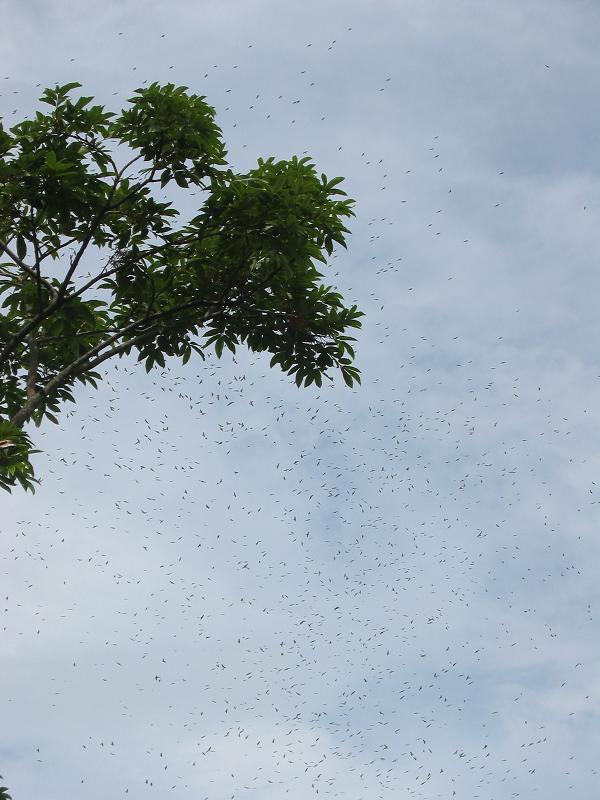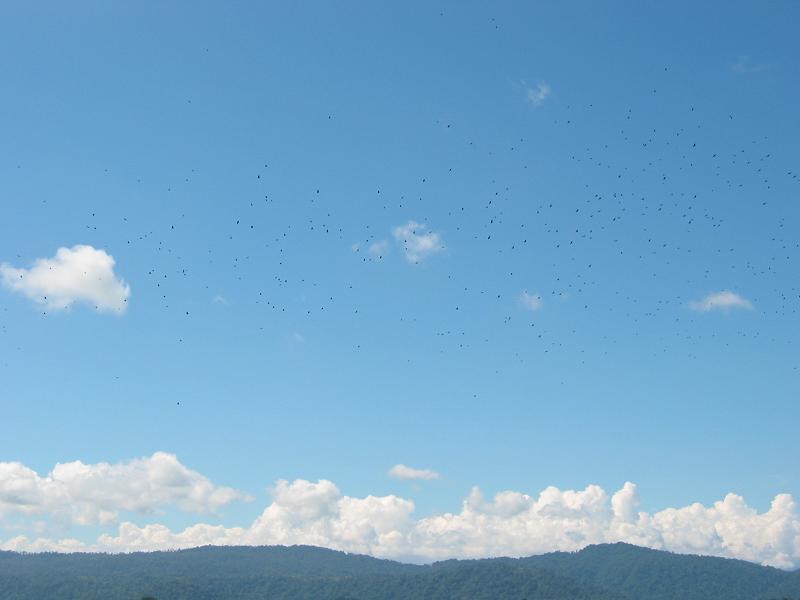How do you count 2.8 million hawks? First of all, it's impossible of you
try to count them in a vortex:

So you wait until the hawks "stream" out of the vortex in a nice line
that's "easy" to count. (Think counting people in a marathon vs. counting
people in a mosh pit).
A nice stream:

A writeups about a few days:
October 5th:
Friday was a good day for hawkwatching. Sunday and Monday were equally
good. It all started Friday at 10 AM. Imagine a stream of Broad-winged
Hawks, between 1 and 40 hawks wide. Now imagine this stream going
directly overhead at a rate of approximately seven birds every second.
Now imagine this stream continuing nonstop for one hour. The result:
24,000 birds in one line. Wow.
Friday's total for BWs was 112,126.
Saturday I only worked a halfday but I still saw most of the 39,000 BWs
that passed that day. Sunday was 107,000 BWs; Monday was 128,000BWs.
Did I mention that somewhere around 400 peregrines have passed? I have
only seen about 3/4 of them, but that's still A lot. (Sometimes you
don't see a bird because you're looking in the other direction counting a
huge line of something else, like broad-wings).
October 20th:
October 11 was my free day, and I took a bus to the city to get money at
the bank. When I returned, I found out that they had seen 348 peregrines
pass that day. OUCH. The previous record for a big peregrine day was
just over 270 'grines, and I missed a 348-peregrine day!
The next day (OCt 12) I was at the tower and we counted 352 'grines, so
now I don't feel so bad. It was pretty cool. From 1PM to 2PM we saw 76
peregrines.
Yesterday was exciting, too, because it was our first day that was big for
multiple species. We counted over 250,000 raptors, mostly Turkey Vultures
and Swainson's Hawks, but with ten or twenty thousand broad-wings mixed in
there, too. In one hour five of us counted over 112,000 hawks: it was
insanity. At any one time there were between 10 and 15 vortices in view,
each with a few thousand hawks. Sometimes we'd have 7 lines of raptors
passing by. At one point I was counting the turkey vultures in three
lines of hawks to the south of the tower when someone said, "hey listen."
(Usually when it's crazy in the tower people are talking a lot to try to
coordinate all our efforts). Everyone shut up, and we could all hear a
"whooshing" sound. It was the sound of a line of Turkey Vultures and
Swainson's Hawks passing so low over the tower that we could hear their
wingbeats. Neat-o.
I didn't take any pics, because like I said it was absolute insanity;
when there are that many hawks they are always splitting into multiple
groups and then regrouping with different hawks and basically doing
everything they can to try to confuse you. I'll check my camera because I
leave it out in the tower; maybe someone else took a second to document
what it was like.
ed. note: no luck on the pics :(
November 12:
The biggest hour counting by myself. As the other people in the tower
were eating, I was alone for an hour. At first it was ok, with just one
or two lines of mostly Turkey Vultures with a few hawks mixed in. Then, a
third line appeared from a closer vortex. Then, a fourth from an even
closer vortex. The entire hour, there were always between 1 and 4 lines
to the south of the tower. At the end of the hour I had counted over
38,000 turkey vultures, 2 Broad-winged Hawks, 102 Swainson's Hawks, and 13
Wood Storks.
After counting through the end of November, I took off for the rest of Costa
Rica. I saw tons of cool birds (obviously). It was great, although I didn't
see anything in MONTEVERDE, the most famous birding place in the world! It was
raining pretty hard, and the area was living up to its cloud-forest billing: the
forest was amazingly dense, making it nearly impossible to see any birds that
weren't directly in front of you. Add to that rain, and the fact that the
forests are in a cloud, and the birding gets tough.
Here's some pictures and a list of birds I saw
in Costa Rica.

